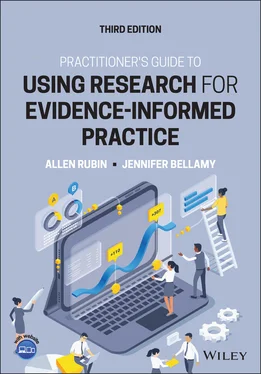Countless specific kinds of EIP questions would be applicable to a hierarchy where qualitative studies might reside at the top. We'll just mention two more examples: Are patient-care staff members in nursing homes or state hospitals insensitive, neglectful, or abusive – and if so, in what ways? To answer this question, a qualitative inquiry might involve posing as a resident in such a facility.
A second example might be: How do parents of mentally ill children perceive the way they (the parents) are treated by mental health professionals involved with their child? For example, do they feel blamed for causing or exacerbating the illness (and thus feel more guilt)? Open-ended and in-depth qualitative interviews might be the best way to answer this question. (Administering a questionnaire in a quantitative survey with a large sample of such parents might also help.) We cannot imagine devising an experiment for such a question, and therefore again would envision experiments at the bottom of a hierarchy in which qualitative interviewing (or quantitative surveys) would be at or near the top.
3.3 Which Types of Research Designs Apply to Which Types of EIP Questions?
Chapter 1identifies and discusses six types of EIP questions. If research hierarchies were to be developed for each of these types of questions, experimental designs would rank high on the ones about effectiveness, but would either be infeasible or of little value for the others. Qualitative studies would rank low on the ones about effectiveness, but high on the one about understanding client experiences.
Let's now look further at some types of research studies that would rank high and low for some types of EIP questions. In doing so, let's save the question about effectiveness for last. Because the fifth and sixth types of EIP questions – about costs and potential harmful effects – tend to pertain to the same types of designs as do questions of effectiveness, we'll skip those two so as to avoid redundancy. The point in this discussion is not to exhaustively cover every possible type of design for every possible type of EIP question. Instead, it is just to illustrate how different types of EIP questions imply different types of research designs and that the research hierarchy for questions about effectiveness does not apply to other types of EIP questions. Let's begin with the question: What factors best predict desirable and undesirable outcomes?
3.3.1 What Factors Best Predict Desirable and Undesirable Outcomes?
Later in this chapter, we'll see that correlational studiesrank relatively low on a research hierarchy for questions about effectiveness. We'll see that although they can have value in informing practice decisions about the selection of an intervention with the best chances of effectiveness, other designs rank higher. Experimental outcome studies, for example, rank much higher. But for questions about circumstances or attributes that best predict prognosis or risk, correlational studies are the most useful. With these studies, multivariate statistical procedures(statistics that account for multiple factors at once) can be employed to identify factors that best predict things we'd like to avoid or see happen.
Returning to the foster-care example discussed earlier, suppose you are a child welfare administrator or caseworker and want to minimize the odds of unsuccessful foster-care placements. One type of correlational study that you might find to be particularly useful would employ the case-control design.A study using this design to identify the factors that best predict whether foster-care placements will be successful or unsuccessful might proceed as follows:
1 It would define what case record information distinguishes successful from unsuccessful placements.
2 It would obtain a large and representative sample of foster-care placements depicted in case records.
3 It would then divide those cases into two groups: those in which the foster-care placement was successful and those in which it was unsuccessful.
4 It would enter all of the placement characteristics into a multivariate statistical analysis, seeking to identify which characteristics differed the most between the successful and unsuccessful placements (when all other factors are controlled) and thus best predicted success or failure.
If your previous research courses extolled the wonders of experiments, at this point you might exclaim, “Wait a minute! Why rank correlational studies above experiments here?” It's a good question, and we'll answer it with three others: Can you imagine the staff members of any child welfare agency permitting children to be assigned randomly to different types of foster placements? What would they say about the ethics and pragmatics of such an idea? What might they think of someone for even asking?
Correlational studies are not the only ones that can be useful in identifying factors that predict desirable or undesirable outcomes. Qualitative studies can be useful, too. For example, let's return to the question of why so many homeless people refuse to use shelter services. As is mentioned in Chapter 1, studies that employ in-depth, open-ended interviews of homeless people – or in which researchers themselves live on the streets among the homeless and experience what it's like to sleep in a shelter – can provide valuable insights as to what practitioners can do in designing a shelter program that might alleviate the resistance homeless people might have to utilizing the shelter.
3.3.2 What Can I Learn about Clients, Service Delivery, and Targets of Intervention from the Experiences of Others?
In Chapters 1and 2, we can see that some studies suggest that one of the most important factors influencing service effectiveness is the quality of the practitioner-client relationship, and that factor might have more influence on treatment outcome than the choices practitioners make about what particular interventions to employ. We also know that one of the most important aspects of a practitioner's relationship skills is empathy. It seems reasonable to suppose that the better the practitioner's understanding of what it's like to have had the client's experiences – what it's like to have walked in the client's shoes, so to speak – the more empathy the practitioner is likely to convey in relating to the client. In other instances you may want to learn about the experiences of others – not just clients – to inform your practice decisions. For example, gaining insight into practitioners' experiences using a new caregiver support intervention or family members' experiences caring for an elderly client can help inform your practice decisions about implementing a caregiver support intervention in your own practice.
When we seek to describe and understand people's experiences – particularly when we want to develop a deep empathic understanding of what it's like to walk in their shoes or to learn about their experiences from their point of view – qualitative studies reside at the top of the research hierarchy. Qualitative research can provide rich and detailed information that is difficult, or even impossible, to capture accurately or fully in a quantitative study. Gambrill (2006) illustrated the superiority of qualitative studies for this EIP purpose via a study by Bourgois et al., (2003), which examined the kinds of risks taken by street addicts. Bourgois immersed himself in the “shooting galleries and homeless encampments of a network of heroin addicts living in the bushes of a public park in downtown San Francisco” (p. 260). Virtually all of the addicts reported that when they are surveyed with questionnaires, they distort their risky behavior. Often, they underreport it so that it takes less time to complete the questionnaire. Also, they may deceive themselves about the risks they take because they don't want to think about the risks. Consequently, quantitative methods like surveys would rank lower on a hierarchy for this type of EIP question.
Читать дальше












